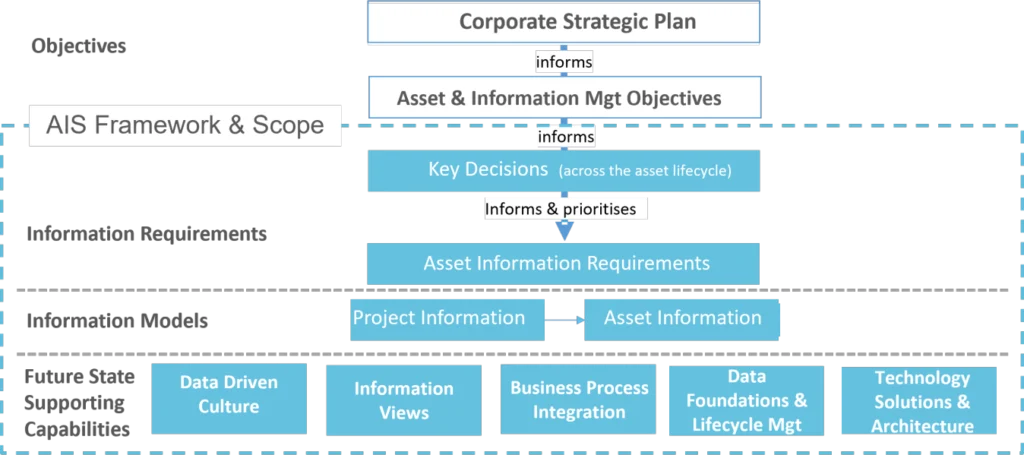
This post targets asset owners, managers and operators who live with ongoing frustrations caused by a lack of fit for purpose asset information to support the decisions they make.
The question in the title, posed in a recent podcast by #Simon Sinek, led me to question why, when approaches are available, do many people and organisations continue to live with significant information challenges impacting their efficiency and effectiveness.
Take an Asset Information Strategy (AIS). A tool well documented in ISO 5500X and IAM’s Anatomy of Asset Management amongst others. Well constructed, it sets out a clear vision for how business stakeholders (employees, customers etc.) will use information in the future (1,3,5 year horizons) and the capabilities required to enable it. The AIS typically sets out the position today and an initiative roadmap to address the gaps to the future state.
What are some of the challenges then preventing AISs from being deployed to systematically improve organisational asset management maturity?
1. Value case
Discussions indicate many senior business stakeholders struggle to see the connection between an Asset Information Strategy and the benefits it will deliver. Consequently, they frequently do not provide the business prioritisation, support and funding needed to develop and execute the AISs through their sub-initiatives.
Some of you may have read our previous post covering Key Business Decisions. The Key Decision approach provides stakeholders with a direct line of sight as to what they will get for their money and time, i.e. creating a clear link between organisational objectives, value at stake, information issues, root causes and initiatives driving the capability uplift needed to realise value. Key Decisions typically involve a lot of value (safety, reputational, regulatory, financial etc.) for the organisation. They range from strategic decisions regarding the level of customer demand you plan to meet, to operational decisions regarding the work you are prioritising to maintain levels of service etc. A Key Decision approach takes away subjective value improvement statements, replacing them with discrete deliverables and value.
2. Business Ownership
Business ownership of an Asset Information Strategy is pivotal to its success in prioritisation, approval and funding stages. The Key Decision approach assists as each decision typically has a passionate business stakeholder with skin in the game for its improvement. If the passion or uplift benefit is not there, then the strategy’s focus should have pivoted to a different decision with uplift potential. While IT functions are critical partners in the uplift of asset information capabilities, the strategy’s passion, drive, and sustainability should be driven by business stakeholders.
3. Specificity
While a high-level strategy and vision are critical to setting and communicating direction, the key to value lies in detail. By this, we mean decision improvement objectives should be underpinned by a detailed understanding of the information elements and capabilities that are not fit for purpose and, most importantly, ‘why’ they are not, informing what needs to change. The change diagnosis here needs to span all capability domains, i.e. process, data, technology and people. The detail provides the glue and line of sight between the value at stake, the decision uplift, and the improvement required. It also avoids follow up business cases to identify the detail.
4. Bridging the Business-IT divide
A range of asset information capabilities support effective asset information delivery either directly managed or supported by an organisation’s IT function. IT stakeholders should therefore be a key input group to an AIS strategy. After all, they will be responsible for enabling much of the capability uplifts referred to in (3), e.g. master data management, logical information models, technology gaps etc. An asset information capability model is a critical component of an AIS. It sets out the various asset information capabilities required to improve the Key Decisions. Often your in house architect team will have a model that can kick start the development of one that is fit for purpose for your organisation.
We frequently see a significant discussion between Business and IT areas as to what an asset information strategy is vs a data strategy vs an information systems strategy. In many instances, we see an asset information strategy positioned in competition with an IT-led information-driven strategy instead of being a critical input.
Without a considerable debate on the difference, our recommended focus starts with a discussion between the various stakeholders regarding what is needed from the proposed strategy, i.e. the objectives. A management decision can then be made regarding whether separate strategies are produced or whether an asset information strategy focus is sufficient and if the AIS is to pick up the data and system requirements within its scope.
5. Strategy to Execution
The nightmare for any strategist. A great piece of work setting out a clear vision of the future state and a roadmap to get there. Six months later, the report is gathering the cyber equivalent of dust and has not moved forward.
Current business pain, Executive sponsorship, a strong value case, passionate change champions, plenty of hustling, a problem-solving mindset, more than a strong dash of perseverance and well-timed interventions in the prioritisation decision-making process are just some of the minimum essential ingredients to get the AIS underway. Anything less will likely see some version of groundhog day for the next ISO55000 audit. 😊
To conclude on a bight note, there are multiple organisations in our collective networks who have made the leap and are implementing AISs. The changes are transforming the way they deliver their levels of service and, significantly, are transforming their employees’ lives and daily experiences for the better.
For all those who have made the jump, please feel free to add some of your successful approaches to overcoming the blocks.

